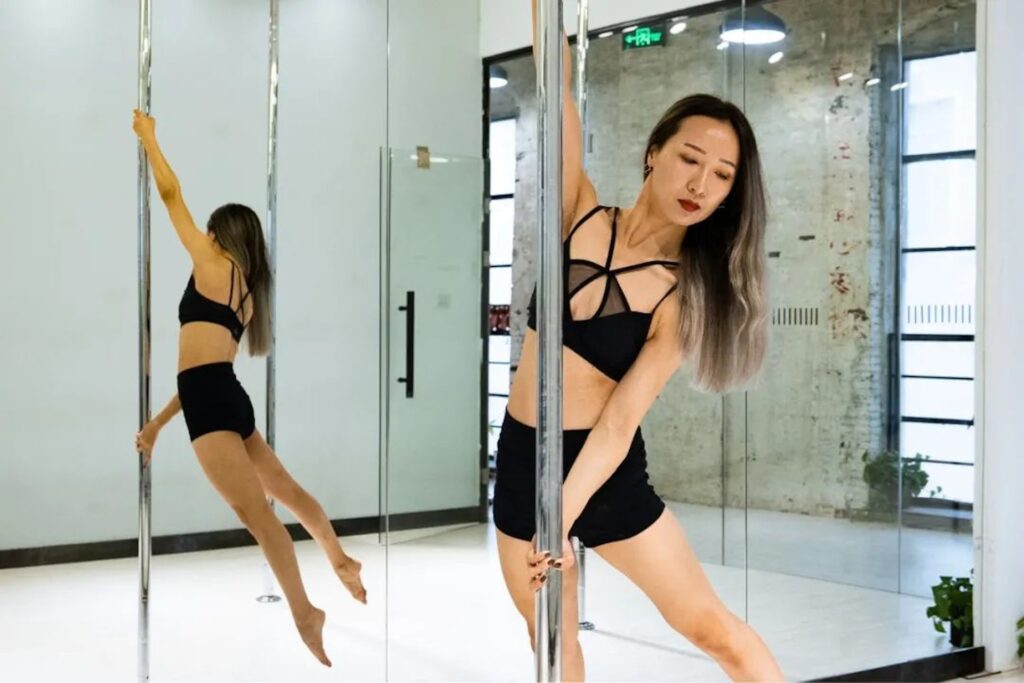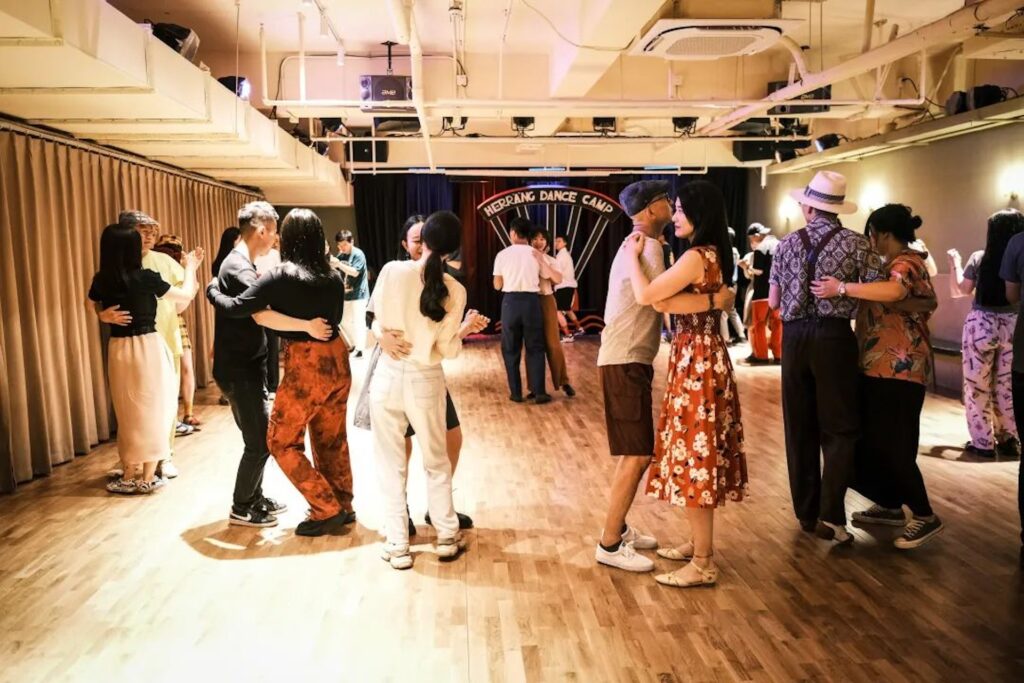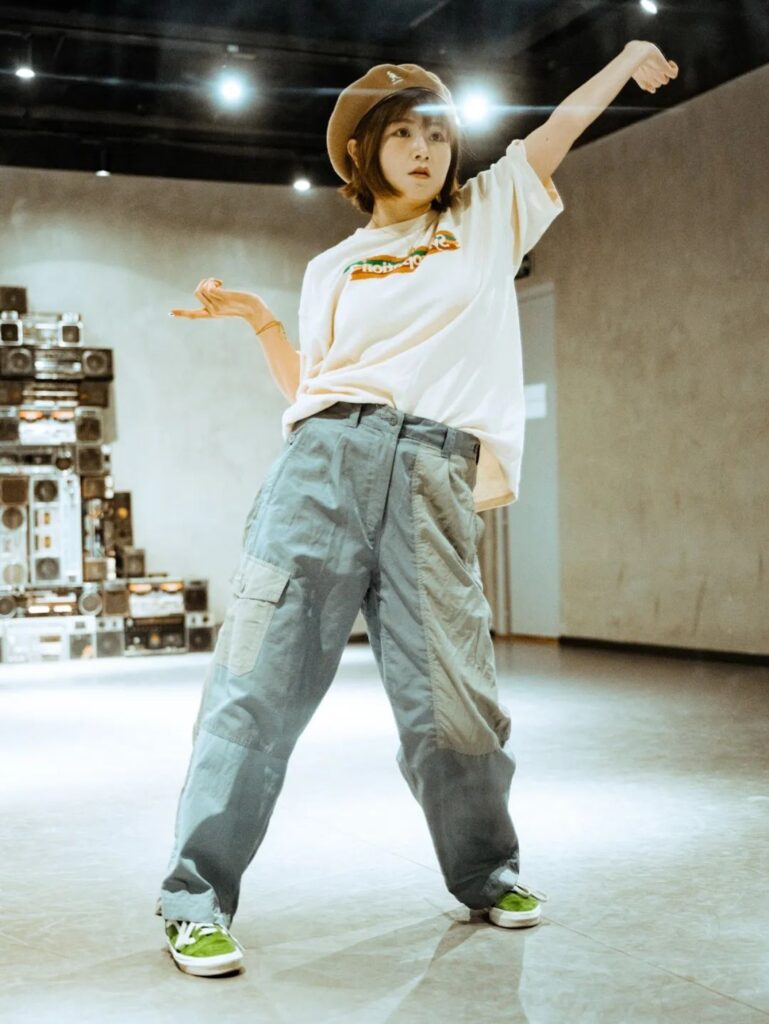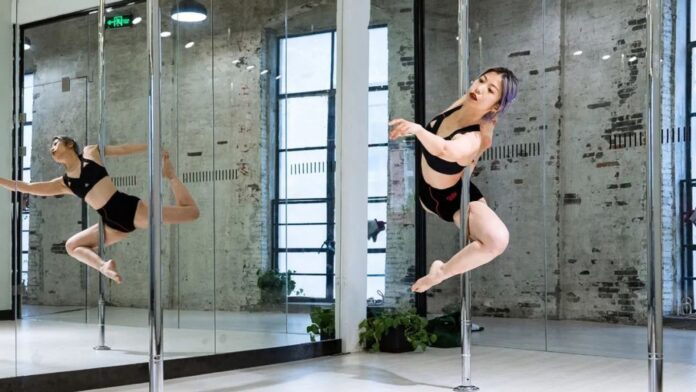“Dancing,” has become the latest lifestyle trend among many urban youths. Some sculpt beautiful body lines through dancing, some use it as a temporary escape from reality to relieve stress, and others find like-minded friends in the loneliness of big cities through dancing. Visiting studios specializing in swing dance, pole dance, and street dance, and talking with young people devoted to dance, we found that the problems they face in real life are no different from the tens of millions of young people in the city – stress, anxiety, loneliness, and information overload. However, when they start to dance, all these real-life worries are somewhat relieved.
Julia is quite petite. At a height of 163 cm, she once weighed only around 70 pounds and suffered from hypotension, vertigo, and low immunity. For health reasons, she started practicing pole dancing four years ago. She quickly found that it was far more interesting than repeating anaerobic exercises in the gym. As a PR officer for a brand, she often rushed to dance classes after work when she was busy. After finishing class, she would return to the company to work overtime, insisting on not cutting down on pole dancing practice time.
Pole dance training is not easy; it tests strength and requires flexibility. The pain from the friction of the pole on the beginner’s skin is already a hurdle, and during breaks after classes, bruises often appear on the body. Fortunately, over the years, her efforts have paid off. Julia’s weight has increased, her body has become stronger, and more importantly, her body lines are even more beautiful than before. When she wraps herself around the pole, the muscle lines on her shoulders are clearly visible. When it comes to pole dancing, the initial aspiration of female practitioners is consistent: strength and beauty.

Shuting, who practices dance with Julia, is a physics graduate and a “top student.” Her full-time job is as a female scientist in a research center. Her daily work involves wearing a mask and a white coat and requires meticulous rigor. For her, the joy of pole dancing is that “the world becomes very simple, with only the teacher, classmates, and a pole. It’s pure and a great stress relief.”
She already had a fitness habit, but compared to weightlifting, pole dancing has “more challenging moves and aesthetic sense.” She is flexible and can easily contort herself into various difficult moves. Seeing the beauty of her body reflected in the mirror gives her a very direct sense of accomplishment.
However, declaring her love for pole dancing publicly is a delicate matter. When Julia mentions to others that she learns pole dancing in her spare time, the conversation sometimes falls silent after an “oh wow.” “I would show them videos of myself on my phone, of various styles, some more sexy, and some more focused on strength,” she says, hoping to break down some of the stigma around pole dancing.
The pole dance studio where she usually practices has large windows, the light streaming in very bright, and the renovated old factory building has an industrial feel. The founders, Kim and Krissy, explain that having the studio here is also a way to hope that pole dance, a genre that has been endowed with too much erotic meaning, can exist in a more everyday and artistic form. Especially in Shanghai, where people are very tolerant of new things and different cultures, pole dancing is gradually returning to the dance itself and becoming a daily hobby.
Most women who come to practice pole dancing are well-educated, independent white-collar workers, and a female community is gradually formed. No matter how familiar they are with each other, the relationship is always friendly. When someone performs a difficult move, others will clap and cheer; or if someone fails repeatedly, they will also receive encouragement and comfort. They don’t have to worry about the judgment of outsiders, only the affirmation between each other and self-affirmation. Julia and Shuting both spent some bottleneck periods in this good atmosphere. “There is a mutually nourishing atmosphere between women, and the power is very strong. So pole dancing will definitely make people more and more confident.”
On Friday afternoon, in a certain office building in Haidian Liudaokou, Guobao at her workstation became restless – there was a swing dance party in the evening. Around five o’clock, she would start to apply lipstick, start listening to music, and start inviting friends to dinner before the dance. Even her colleagues could see her uncontrollable joy.
She works as a content planner in an internet giant. The work pace is fast in the complex structure of the big company, chasing progress on the internet. She has to squeeze into the subway for an hour to go to the company every day, and at the company, “my eyes are almost never off the spreadsheets and documents on the screen,” interspersed with countless phone calls and meetings. She is already married, and in addition to her work, she has to consider managing the household and dividing up chores. When she gets home after work, she often has to listen to her husband’s work troubles, take care of his emotions, “sometimes, it’s the double overlay of stress and anxiety.”

The swing dance studio that Guobao often goes to is located in the basement of the Rizhao Building in Beijing’s Guomao Business District. The exterior of the building is like most high-rises in the business district, looking somewhat cold and desolate. But following the hallway into the basement and pushing open a door, it seems to be entering another world, with dreamy lighting and jazz music one after another. People greet each other into the dance floor, ready to start a dance at any time. The men and women in the dance pool have intoxicated expressions on their faces, and there are bursts of cheers and infectious laughter from time to time. Because it is underground, the mobile phone signal here is very weak, and no phone calls will ring in the middle. Guobao said that the few hours of dancing are “completely my own time”. Even during breaks, sitting aside drinking and listening to music, she doesn’t think about checking her phone (there is wifi in the room). “For modern people, having an hour without touching the phone is such a luxury.”
Swing dance is named after swing jazz and rose in the United States during the 1930-1940s. At that time, there was a great depression, and people sought simple happiness and comfort from dance. This dance is easy to learn, does not require complex moves and skills, just needs a dance partner and a piece of music, and you can easily dance. At this time, age, gender, background, etc., become unimportant. In the dance pool, people enjoy the joy of music and dance on an equal basis. Perhaps this is why swing dance is getting more and more popular. Now, in many first- and second-tier cities, there are always a few days a week when enthusiasts drill into the bases of various cities for a temporary escape from reality. Moreover, this dance is naturally social, and many people have therefore walked out of their small social circles and re-acquainted themselves with others.
Du Le is in his early thirties, having lived in both Beijing and Shanghai. Before he encountered swing dancing, he was a typical “homebody” – floating in the big city, not good at socializing, spending most of his time silently working and returning home alone. He has a gentle temperament, with little interest in more “masculine” competitive activities. When he first tried swing dancing, Du Le, who was initially too shy to express himself, found that he had “opened up.” It turned out that holding hands with others, linking arms, and establishing physical connections were not as unnatural as he thought. Dancing became his channel for release and expression. The joy was so direct that at its peak, he would travel back and forth between the city and his relatively remote home almost every day, to attend classes and go to parties. Each way took over an hour. After the revelry swiftly ended, “like Cinderella, he always had to rush to catch the last subway home.”
Recently, he moved and switched cities for development. His company and the dancing venue were still far apart, so he deliberately rented a house in between to conveniently commute between the two starkly contrasting realities. This also led him to meet a group of like-minded friends. They danced together, ate together, and shared deep conversations, becoming deeply involved in each other’s lives. For him, drifting away from his hometown and living in the big city, it “felt like having a family in this metropolis.”
Beibei, one of the founders of Cat Angle Studio, said that the essence of swing dancing is a “social atmosphere.” “Dance itself may only make up part of the atmosphere, the rest comes from chatting and sharing music with others.” For many young people in big cities who often feel lonely, this kind of pure and non-purposeful social opportunity is invaluable. Therefore, unless prevented by force majeure, the Cat Angle’s Saturday night parties are almost unstoppable, even during Chinese New Year.
Most of the people who come to dance are young, but there are also elders who can energetically dance until the early morning. People from all walks of life participate, with programmers and finance professionals breaking stereotypes due to their high representation. Beibei likes to discreetly observe each participant during the parties, noticing the multifaceted and interesting sides of people revealed on the dance floor. “Some people seem restrained and cold, but after a few drinks, they might be the ones who enjoy themselves the most; some people might offend others when speaking, but when they start to dance, you can feel their energy. Dance seems to supplement many aspects that daily interpersonal communication cannot reach. Perhaps people are instinctively attracted to this kind of simple rhythm and the joy of exploration. Expressing oneself through street dance, sweating profusely, feels so liberating!”
Xiao Kui, born in 1991, works as a text reporter for a traditional media company in Shanghai. Her salary isn’t high, but she doesn’t have to be office-based. In the four or five years after graduation, while seeing her classmates and friends getting promotions and raises, she was reluctant to give up her low-paying job, because she uses her spare time – outside of reporting and writing – to fully dedicate herself to street dancing.

She first encountered street dance three years ago, by chance, when she took an old-school street dance class. As a journalist, she was always chasing various hot spots, always in a state of information overload, but during that one hour, all her attention was focused on her own body. Rapid physical activity caused her brain to automatically secrete a large amount of dopamine. She learned quickly, felt a continuous sense of achievement, and began to love this sport. From the physiological pleasure of secreting dopamine, to gradually being able to follow the music and challenge movements, she later realized that dancing could also be an attitude.
She remembered when she was in college, doing cheerleading, always worrying about whether she looked good, slender, and had a sweet expression. But in street dance, these didn’t matter anymore, what mattered was expressing herself according to the music, which she found incredibly liberating. Once, someone in her circle of friends commented that her dancing “didn’t look like a girl at all.” “At that time, I thought to myself, ‘what do you know?'” Xiao Kui responded with an indifferent expression.
Now, she is well known in her circle of friends as a “time management master.” Outside of work, she goes street dancing 3-5 times a week. If there’s a street dance class on a certain day, she definitely gets up early to basically finish her daily work; when she leaves the house, her big backpack is always heavy, with a laptop inside that she can open anytime, anywhere to get work done and make use of fragmented time. This way, she can carve out relatively large chunks of time for street dance. What she fears most is: after class, she looks at her phone and sees dozens of messages popping out, always worried about missing some hot news event. But the more this happens, the more she can’t give up dancing, the more she values the time to forcibly liberate herself from the flood of information. She toggles between two states: concentrating in class, and quickly handling messages during the few-minute breaks.
A year ago, Xiao Kui decided to move closer to the street dance studio for convenience. Over the past two years, in first- and second-tier cities, more and more white-collar workers like Xiao Kui have started to dance. In a street dance studio in the heart of Shanghai, because there are so many dance enthusiasts, sometimes they have to queue up to maintain the order of the class. A larger studio can hold up to thirty or forty people in one class. The rhythmic music fills the entire space, with the rumbling of the nearby subway from time to time, but those immersed in dance rarely get distracted by these noises.
When I met Jessica, her petite figure was wrapped in an oversized T-shirt, trousers, and baseball cap, giving her a very quiet look. But when she starts to dance, she’s completely different: her body is flexible, her movements are decisive, and she’s fully focused. She works in the finance industry, and because of the time difference with her foreign clients, she usually starts working at 9 p.m. This unusual lifestyle leaves her with virtually no social circles; her life mainly consists of work. Before starting street dance, Jessica thought of herself as “introverted, laid-back, and without any particularly intense hobbies.”
Two years ago, she participated in a live recording of the variety show “This is Street Dance” as an audience member, and was shocked by the dedication and selflessness of the professional dancers. After it ended, she thought about her ample free time during the day, and figured it was perfect for trying out street dance. Initially, because she had been staying at home for a long time with low physical strength, she couldn’t keep up with the rhythm at all, “I almost thought about giving up.” But after class, she felt extremely joyful, “the feeling of sweating profusely is really refreshing, and the brain is completely relaxed.” This feeling fascinated her, so she persisted, and has been dancing for two years now. Now, almost every day, she comes here, sometimes practicing for four to five hours a day until late at night, then goes home to start work. Day after day. Her life has subtly changed: to adapt to the high-intensity training, she has started doing some physical exercises consciously; the playlists in her phone have gradually been replaced by music suitable for street dance; her clothing style has become more and more loose. She finally feels relaxed.
Recently, Jessica, who thinks of herself as having a “non-competitive” nature, began to try battles in street dance, never expecting that she could actually do it. “Sometimes, when your move’s logic can be perceived by the other person, and the other person responds with their body, it feels especially satisfying.” In fact, everyone has a desire to express themselves. To shed some old perceptions and express a new self. Young people in big cities are always facing similar problems: busy with work, lonely at heart, always distracted by a large amount of information, yet feeling a sense of emptiness. “Dance, dance, or we’ll get lost.” This quote from modern dance artist Pina Bausch may be a kind of guidance.
